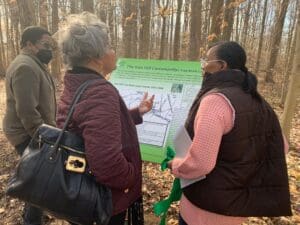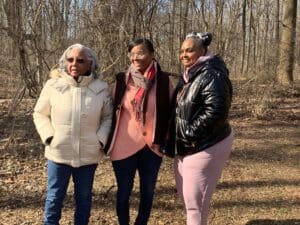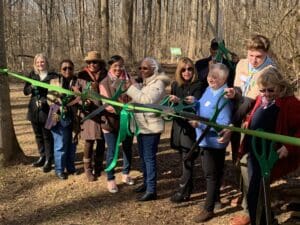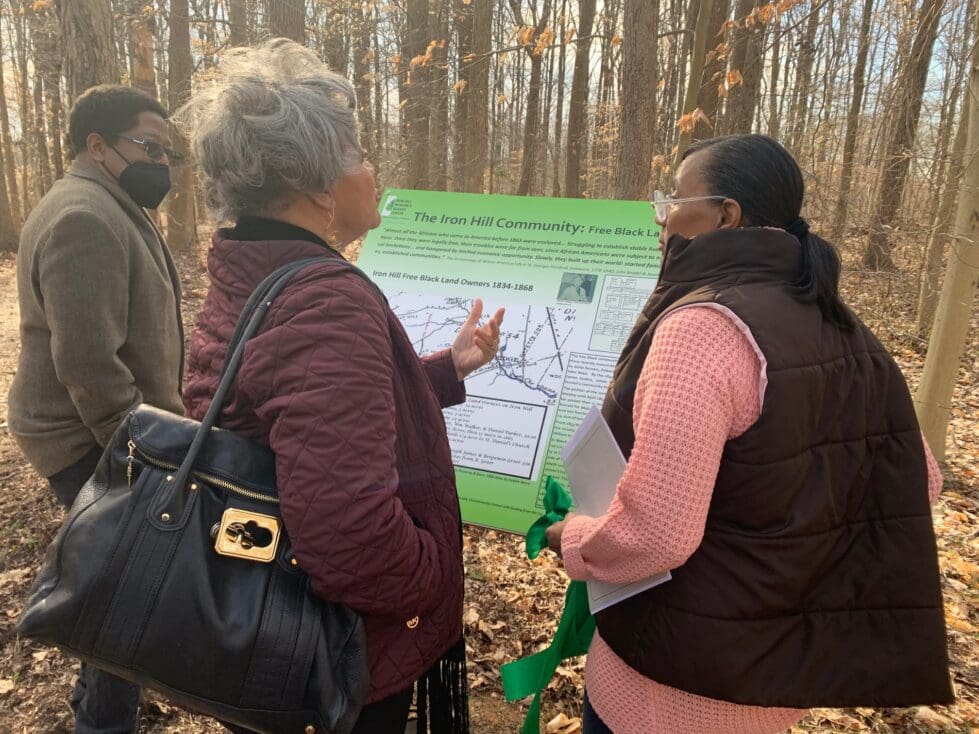
Donna Johnson, right, talks witih another Iron Hill family member about the opening of a new African American History Trail at the museum and school.
A new history trail at Iron Hill Museum documents the existence and lives of free Black families who began settling there in the 1930s.
No one knows if any of those who lived there had been slaves, although it’s certainly possible, historians said after the trail’s ribbon cutting on a gloriously sunny afternoon.
The families included the Congos, Websters, Earls, Smiths and more.
Some had property large enough to devote their work lives to. Others worked neighboring farms for pay, and some worked in the nearby iron mines.
Family members of those who lived there called the dedication of the African American History Trail an emotional moment.
“To see this is so empowering,” said Janice Alexander, who spent her tween and teen years there. “Back then you would never think that we would get here, that this would be a monument, that this would be something that everybody would be interested in.”
Opening the trail was one of three goals of a $25,000 Community Environmental Project Fund grant that the Iron Hill Museum received from the Delaware Department of Natural Resources and Environment.
It included establishing the trail, including signage installed by Eagle Scout Cameron Mills; using native plants to create a demonstration garden using a German horticulture technique; and coming up with a plan to rid the property off Old Baltimore Pike of invasive species.

Attending the Iron Hill Museum’s ribbon cutting for its new African American History Trail were family members, from left, Shirley Earl; her daughter Donna Johnson; and her niece, Janice Alexander.
“The African American History Trail allows the Iron Hill Museum to broaden its interpretation of the schoolhouse by including the under-recognized history of an independent, long-standing free African American community of landowners on Iron Hill, placing it into the context of a society in which free and enslaved Blacks co-existed before the Civil War,” said Debbie Keese, museum board member who spent two years researching the property and families.
Those families survived post-war reconstruction and segregation, with everyday struggles supported by community and church, she said.
“It is hoped that today’s families visiting the site will be able to make comparisons between past and present-day politics, social norms, family structures, and educational practices while inspiring thoughtful discourse about issues of equity and justice, both social and environmental, in a safe, comfortable and beautiful space,” she said.
Iron Hill anniversary
The state needs more African American history trails, said Ricky Mouse Smith, president of Delaware’s branch of the National Association for the Advancement of Colored People.
There are stories to be told up and down the state, he told those gathered for the day.
Iron Hill’s property — not far from the I-95 tool booth — includes Iron Hill School No. 112C, one of 87 schools founded by Pierre S. du Pont to educate Black children, who were ignored by Delaware’s state schools at the time.
It is the school’s 100th anniversary.
Family member Shirley Earl, who attended the groundbreaking with her daughter, Donna Johnson, and niece, Janice Alexander, went to school at No. 112C.
The area residents chipped in and bought a bus so they could send their children to Louis Redding Middle School. Eventually, most graduated from Howard High in Wilmington.
Friday was a proud moment, Johnson said, particularly because it would have been her grandmother Mary’s 150th birthday. She was born Feb. 24, 1873.

Officials and family members gathered for the ribboning cutting of Iron Hill’s new African American History Trail.
Alexander remembered moving into her grandmother’s home on the property in the early 1970s when she was 9. She lived there until she was 18, when the house burned.
“There’s so many memories,” she said, as she started walking the trail. “We knew these trails like the back of our hands because we used to get together here. We’d call each other on the phone and say, ‘Meet me at the trail,’ and we’d ride bikes all through these trails.
“It was just fun. We were kids. Just to be back here was just fun for us.”
The black families were one of four unique groups to live on or make use of the property, said Iron Hill Board President Robin Broomall.
The first were native Americans, who were attracted to the jasper quartz that they used for tools and other things, she said.
The property also was a gathering spot for George Washington and the Marquis de Lafayette, who stood with other soldiers on Iron Hill’s high point, watching the British come in by river and also marching up the Baltimore Pike to the battle at Cooch’s Bridge one mile away.
Then the Irish and Welch came to the property to mine the iron ore and sell it, both to businesses here and overseas.
Finally, she said, the community of free Blacks began to buy property and live there.
She praised DNREC for approving Iron Hill’s grant application.
“You know, small organizations like ours kind of live and die by grants and by having them graciously accept our proposal, we really were able to make great strides in what we wanted to accomplish,” she said.

Betsy Price is a Wilmington freelance writer who has 40 years of experience, including 15 at The News Journal in Delaware.
Share this Post




